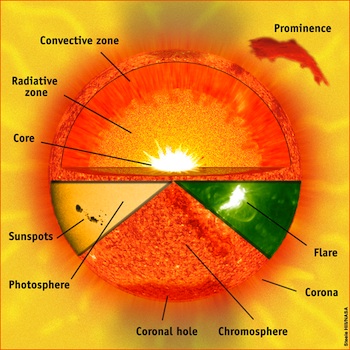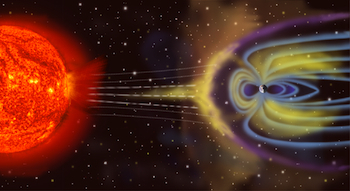2.1.2: The Sun
- Page ID
- 15542
The Sun is a giant thermonuclear furnace with an internal temperature estimated to be 15 million degrees Celsius. Hydrogen nuclei collide at such an extremely high speed they fuse to form helium nuclei generating enormous amounts of heat in the core. The heat works its way to the luminous outer surface called the photosphere. Here temperatures fall to about 6000oC generating a maximum wavelength of emission in the visible end of the electromagnetic spectrum. Above the photosphere lies the chromosphere and the corona. The chromosphere acts as a boundary between the cooler photosphere and hotter outermost layer the corona.

Video: "Where does the Sun get it's energy?"
Sunspots are dark, cooler regions of strong magnetic fields on the photosphere whose activity varies through an eleven year cycle. Solar flares occur in the region of Sun spots, sending energized, charged particles at great speeds toward Earth. They form when the Sun's magnetic energy becomes unstable and collapses causing an explosive heating of gases.

A solar prominence is an arch of gas held above the Sun's surface by strong magnetic fields and lasting up to several months. Their eruptions release massive amounts of amounts of solar material.
Video: Striking a Solar Balance (Courtesy NASA Goddard Space Flight Center (Source))
This short film explores the vital connection between the Earth and the Sun. NASA's Glory mission and the Total Irradiance Monitor will continue nearly three decades of solar irradiance measurements. This crucial data will contribute to the long-term climate record.
The Solar Wind and Auroras
A continuous flow of charged particles (ions and electrons) from the Sun is discharged as a solar wind. At these extremely high temperatures, violent collisions of gases strip charged particles of electrons, and acquire enough speed to escape the gravitational pull of the Sun. As the solar wind streaks toward Earth the flow of particles strikes the Earth's magnetic field deforming it into a tear-drop shaped cavity called the magnetosphere. Inside the magnetosphere are ionized gases from the solar wind and the upper most part of the Earth's atmosphere.

During periods of high solar activity, the solar wind is more dense, travels faster, and possesses more energy. Reaching the Earth's magnetic field it sets off amazing displays of light by exciting atmospheric gases. In the Northern Hemisphere the spectacular light shows are called the aurora borealis or northern lights. In the Southern Hemisphere they are called the aurora australis, or southern lights. Solar flares have a direct impact on modern society. They create geomagnetic storms that deposit excess energy on power grids and satellite components causing them to fail. Solar flares disrupt cell phone communication, television signals from satellites, corrode pipelines and disrupt global positioning systems. They also pose a radiation threat to astronauts orbiting in space.
Video: The Mystery of the Aurora (Courtesy NASAexplorer)


